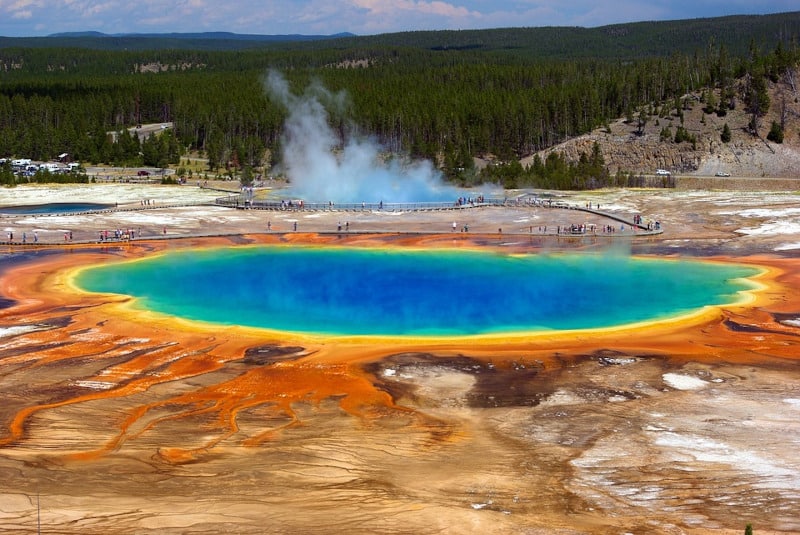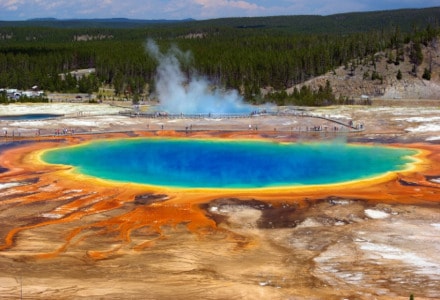
Grand Prismatic Spring Facts
- This gorgeous geological formation holds the understandably grandiose, though wholly deserved, name of the Grand Prismatic Spring. While another feature in its immediate area carries more fame, this marvel is actually the more photographed of the two.
- It’s also famous for its sheer size, as well as its beauty. That’s because it ranks as the third largest of all known hot springs on earth. Only the magnificent Boiling Lake, in Dominica, and Frying Pan Lake in Australia, surpass this site in terms of size.
- Evidence clearly indicates that the local Indigenous Peoples long knew of the existence of this magical structure. The first known sighting of it by a non-native explorer, however, took place in the year 1839. At that time, fur trappers noted its existence.
- Years later, two different expeditions explored the region. The first of these saw it in 1870, also noting another nearby feature. It was the Hayden Geological Survey, in 1871, however, that assigned it the name it now holds, due to its appearance.
- The Grand prismatic Spring forms part of what’s easily one of the best known locations in the world, Yellowstone National Park. Due to its location, and its own natural appeal, it now easily qualifies as one of the most visited tourist sites in the country.
Related Articles
Grand Prismatic Spring Physical Description
The kaleidoscopic majesty of the Grand Prismatic Spring isn’t the only physically impressive attribute of this magnificent work of natural forces. More specifically, that statement holds true due to its sheer physical measurements, as was mentioned previously.
The structure developed a natural shape that’s roughly spherical, though understandably not perfectly so. It’s precise diameter therefore varies, but averages approximately 370 ft (110 m). The extraordinary hot spring further measures roughly 160 ft (50 m) in depth.
Since it certainly qualifies as a hot spring, another aspect of the site is the temperature of the water. This has an impressive source. Due to heating from the magma chamber buried deep beneath the location, this averages about 160 F (70 C) throughout the entire year.
Also due to the great temperature of the water within the Grand Prismatic Spring, evaporation plays an ever present role in its condition. Given its surface area, in addition to that factor, this equates to an impressive average loss of 560 gallons (2,100 L) per minute.
Nature clearly loves balance, however. One might think that such numbers would quickly leave the spring dry. Yet that’s not the case. That’s because the source feeding the awesome spring provides an inflow rate that approximately matches the evaporation rate.
Grand Prismatic Spring Location, Nature, and Ecology
The multi-hued splendor that mankind now appropriately calls the Grand Prismatic Spring formed in a region of the globe already well known for its natural beauty. That’s due to the fact that it formed as part of what’s now known as the continent of North America.
More precisely still, however, the marvel lies in what now constitutes the country of the United States. There, it resides within the confines of Yellowstone National Park. This site, itself incredible, sits neatly in the corner of the states of Wyoming, Montana, and Idaho.
The most recognizable feature of this formation obviously remains its bright, vibrant colors, though. These include shades of orange, yellow, red, green, and blue. These also serve as the origin of the name, since they’re the exact colors dispersed by an optical prism.
These hues themselves actually have an organic basis to them, in addition to a mineral one. That’s due to the amazing fact that enormous quantities of certain microbes that live in its waters. They only live around the edges though, leaving the sterile center blue.
This further alters in accordance with the seasons. During the winter season, these growths of bacteria, known as mats, display a predominantly dark green shade. In the summer season, however, this more commonly tends to be more red and orange in shading.
The Grand Prismatic Spring is a delicate balance of forces, though. Therefore, direct access to the site’s forbidden, including flying drones over it. Though roped off for safety, over the years a total of 20 people have died from falling into its waters, after ignoring warnings.
Features Sharing Its Region
Check out our other articles on 5 Magnificent Brazilian Mammals, Orange Oakleaf, Macquarie Island, Honey Badger, Shoebill, Saltwater Crocodile, Reef Manta Ray

